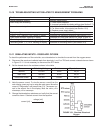
MODEL 54eA SECTION 15.0
TROUBLESHOOTING
15.7.7 Readings are too low.
A. Was the sample tested as soon as it was taken? Monochloramine solutions are moderately unstable. Test the
sample immediately after collecting it. Avoid exposing the sample to sunlight.
B. When was the sensor fill solution last replaced? The monochloramine sensor loses sensitivity, that is, it gen-
erates less current per ppm of monochloramine, as it operates. Generally, calibrating the sensor every week
compensates for the gradual loss in sensitivity. After about two months, the sensitivity will have dropped to
about 70% of its original value. At this point, the electrolyte solution and membrane should be replaced. Refer
to the sensor instruction manual.
C. Low readings can be caused by zeroing the sensor before the residual current has reached a stable minimum
value. Residual current is the current the sensor generates even when no monochloramine is in the sample.
Because the residual current is subtracted from subsequent measured currents, zeroing before the current is
a minimum can lead to low results.
Example: The true residual current for a monochloramine sensor is 20 nA, and the sensitivity is 400 nA/ppm.
Assume the measured current is 600 nA. The true concentration is (600-20)/400 or 1.45 ppm. If the sensor
was zeroed prematurely when the current was 40 nA, the measured concentration will be (600-40)/400 or 1.40
ppm. The error is 3.5%. Suppose the measured current is 800 nA. The true concentration is 1.95 ppm, and
the measured concentration is 1.90 ppm. The error is now 2.6%. The absolute difference between the read-
ing remains the same, 0.05 ppm.
D. Sensor response depends on flow. If the flow is too low, readings will be low and flow sensitive. Verify that the
flow past the sensor equals or exceeds the minimum value. See the sensor instruction manual for recom-
mended flows.
94


















